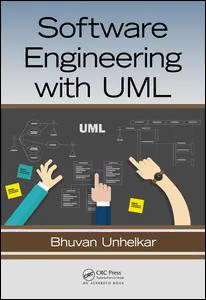Table Of ContentSoftware Engineering
with UML
Software Engineering
with UML
Bhuvan Unhelkar
CRC Press
Taylor & Francis Group
6000 Broken Sound Parkway NW, Suite 300
Boca Raton, FL 33487-2742
© 2018 by Taylor & Francis Group, LLC
CRC Press is an imprint of Taylor & Francis Group, an Informa business
No claim to original U.S. Government works
Printed on acid-free paper
International Standard Book Number-13: 978-1-138-29743-2 (Hardback)
This book contains information obtained from authentic and highly regarded sources. Reasonable efforts have been
made to publish reliable data and information, but the author and publisher cannot assume responsibility for the
validity of all materials or the consequences of their use. The authors and publishers have attempted to trace the
copyright holders of all material reproduced in this publication and apologize to copyright holders if permission to
publish in this form has not been obtained. If any copyright material has not been acknowledged please write and let
us know so we may rectify in any future reprint.
Except as permitted under U.S. Copyright Law, no part of this book may be reprinted, reproduced, transmitted, or
utilized in any form by any electronic, mechanical, or other means, now known or hereafter invented, including pho-
tocopying, microfilming, and recording, or in any information storage or retrieval system, without written permission
from the publishers.
For permission to photocopy or use material electronically from this work, please access www.copyright.com (http://
www.copyright.com/) or contact the Copyright Clearance Center, Inc. (CCC), 222 Rosewood Drive, Danvers, MA 01923,
978-750-8400. CCC is a not-for-profit organization that provides licenses and registration for a variety of users. For
organizations that have been granted a photocopy license by the CCC, a separate system of payment has been arranged.
Trademark Notice: Product or corporate names may be trademarks or registered trademarks, and are used only for
identification and explanation without intent to infringe.
Visit the Taylor & Francis Web site at
http://www.taylorandfrancis.com
and the CRC Press Web site at
http://www.crcpress.com
Janalee and Allen Heinemann
Who succinctly abstracts humanity in all its joys and grace:
Worth Modeling!
Contents
Foreword ..................................................................................................................................xxi
Preface ...................................................................................................................................xxiii
Glossary of Acronyms ..........................................................................................................xxvii
Acknowledgements ...............................................................................................................xxix
Author ....................................................................................................................................xxxi
Unique Features ...................................................................................................................xxxv
1 Software Engineering Fundamentals with Object Orientation ...................................1
Learning Objectives ...........................................................................................................1
Introduction to Software Engineering ...............................................................................1
Learning and Adopting Software Engineering ...................................................................2
Importance of Modeling ....................................................................................................4
Software Engineering Fundamentals .................................................................................5
Programs, Classes, Objects, and Data ...........................................................................5
The Six Fundamentals (Cornerstone) of Software Engineering ......................................6
Classification (Grouping) ...................................................................................................7
Abstraction (Representing) ................................................................................................7
Encapsulation (Modularizing) ...........................................................................................9
Association (Relating) .......................................................................................................10
Inheritance (Generalizing) ................................................................................................10
Polymorphism (Executing) ...............................................................................................11
Software Engineering: A Historical Perspective ...............................................................12
Evolution of Modeling ................................................................................................12
About the UML and Its Purpose ......................................................................................14
UML Usage .................................................................................................................15
Common Errors in Interpreting Software Engineering Fundamentals and How to
Rectify Them ....................................................................................................................16
Discussion Questions ........................................................................................................17
Team Project Case Study ..................................................................................................17
Endnotes ...........................................................................................................................18
2 Review of 14 Unified Modeling Language Diagrams .................................................19
Learning Objectives ..........................................................................................................19
List and Nature of UML Diagrams ..................................................................................19
Nature and Basics of UML Diagrams .........................................................................22
Brief Review of UML Diagrams ......................................................................................22
Use Case Diagrams ..........................................................................................................22
vii
viii ◾ Contents
Activity Diagrams ............................................................................................................24
Class Diagrams .................................................................................................................25
Sequence Diagrams ...........................................................................................................25
Interaction Overview Diagrams .......................................................................................26
Communication Diagrams ..........................................................................................27
Object Diagrams..............................................................................................................27
State Machine Diagram ...................................................................................................28
Composite Structure Diagrams ........................................................................................30
Component Diagrams .....................................................................................................30
Deployment Diagrams ......................................................................................................31
Package Diagrams .............................................................................................................31
Timing Diagrams .............................................................................................................33
Profile Diagrams ...............................................................................................................33
Differences in List of UML Diagrams .............................................................................34
Common Errors in Understanding UML Diagrams and How to Rectify Them ...............35
Discussion Questions .......................................................................................................36
Team Project Case Study .................................................................................................36
Endnotes ..........................................................................................................................37
3 Software Projects and Modeling Spaces: Package Diagrams .....................................39
Learning Objectives .........................................................................................................39
Understanding Different Types and Sizes of UML-Based Projects...................................39
Project Types and UML ..............................................................................................39
Project Sizes and UML .................................................................................................41
Organizing the Project ......................................................................................................41
Identifying Business Objectives ....................................................................................41
Dividing a Project into Smaller, Manageable Parts ......................................................42
Prioritization of Requirements.....................................................................................42
The Three Modeling Spaces in Software Engineering ......................................................44
Modeling of the Problem Space ...................................................................................44
Modeling of Solution Space ..........................................................................................45
Modeling of Architectural Space ..................................................................................45
Mapping UML to Modeling Spaces.................................................................................46
Package Diagrams ............................................................................................................48
What Is a Package in UML? ........................................................................................48
Creating Package Diagrams ........................................................................................48
Namespaces .................................................................................................................50
Strengths of Package Diagrams ...................................................................................50
Weaknesses of Package Diagrams ................................................................................50
Common Errors in Organizing Project Packages and How to Rectify Them ....................51
Discussion Questions ........................................................................................................52
Team Project Case Study ..................................................................................................52
Endnotes ...........................................................................................................................53
4 The Software Development Life Cycle and Agility .....................................................55
Learning Objectives ..........................................................................................................55
Process in Developing Software ........................................................................................55
Contents ◾ ix
UML and Process ........................................................................................................56
Process Elements ..............................................................................................................56
Software Development Life Cycles ...................................................................................58
Iterative, Incremental, and Parallel Process in Software Development ..............................59
Iterative .......................................................................................................................60
Incremental .................................................................................................................60
Parallel ........................................................................................................................60
Time and Effort Distribution in Iterations ..................................................................60
Agile in Software Development .......................................................................................62
The Agile Manifesto ....................................................................................................62
Scrum—An Agile Approach .......................................................................................63
Roles, Ceremonies, and Artifacts .....................................................................................63
Roles ...........................................................................................................................64
Ceremonies ..................................................................................................................65
Artifacts .......................................................................................................................65
Charts ..........................................................................................................................67
Disciplined Agile Development ........................................................................................67
Composite Agile Method and Strategy ............................................................................68
Common Errors in SDLC and Agile Use and How to Rectify Them ...............................69
Discussion Questions .......................................................................................................70
Team Project Case Study .................................................................................................71
Endnotes ..........................................................................................................................71
5 Use Case Models-1: Actors and Use Cases ..................................................................73
Learning Objectives .........................................................................................................73
Use Case Modeling in the Problem Space ........................................................................73
Actors ...............................................................................................................................74
How to Find Actors? ....................................................................................................74
Actor Variations ..........................................................................................................75
Primary versus Secondary Actors ............................................................................75
Direct versus Indirect Actors ...................................................................................76
Abstract versus Concrete Actors ...............................................................................76
Clarifying Actor-Class Confusion ....................................................................................77
Actor Documentation ......................................................................................................78
Actor Documentation for “A10-Patient” ......................................................................79
Actor Documentation for “A60-Doctor” .....................................................................80
Use Cases ..........................................................................................................................81
What Is a Use Case? .....................................................................................................81
Use Case Variations ......................................................................................................81
Finding Use Cases ........................................................................................................81
Use Case Documentation ............................................................................................82
Use Case Documentation Template ............................................................................82
Example: Use Cases in the Hospital Management System ...............................................84
Brief Use Case Documentation for HMS ....................................................................84
Detailed Use Case Documentation for HMS ..............................................................87
Use Case “RegistersPatient” .........................................................................................88
Use Case “MaintainsCalendar” ...................................................................................89

